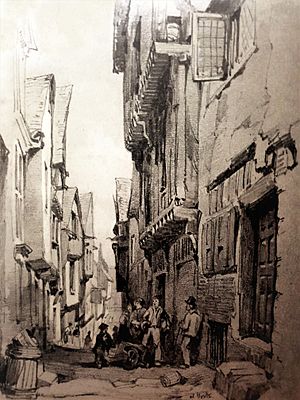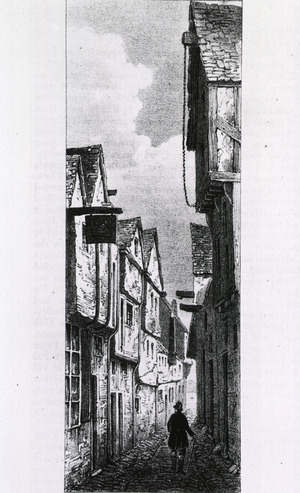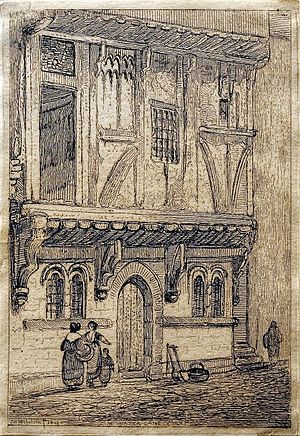The Water Lanes, York facts for kids
The Water Lanes were three old streets in the city of York, UK. They existed during the Middle Ages, a time long ago. These lanes led from a road called Castlegate right down to the River Ouse.
In the 19th century, people knew them as First Lane, Middle Lane, and Far Water Lane. But even earlier, in the 12th century, they had different names: Kergate, Thrush Lane, and Hertergate. Sadly, these historic streets were taken down in 1852.
A Look Back at the Water Lanes
The Water Lanes looked a lot like another famous street in York called the Shambles. They had buildings with "jettied" parts. This means the upper floors stuck out over the street below. But the Water Lanes were much longer and perhaps even more crowded.
These streets were full of medieval buildings packed closely together. They stretched all the way down to the river. Many artists loved to draw the Water Lanes. They enjoyed capturing the long, narrow streets and the unique old buildings. Famous artists like John Ruskin and early photographer William Henry Fox Talbot made drawings and pictures of them.
Life in the Water Lanes was often difficult. The streets had poor sanitation, meaning they weren't very clean. This led to health problems, like the spread of diseases such as cholera. In the 1840s, people trying to improve the city found that many homes didn't have proper toilets. Residents sometimes had to use their neighbors' facilities secretly or go into the street.
Police reports from that time also show that there were many safety concerns in the lanes. There were various problems, and sometimes people even had their money stolen. For example, one story tells of a lady who had her money taken while having her fortune told in a house on Water Lane.
Why the Lanes Were Demolished
For many years, people discussed what to do about the Water Lanes. Should they be improved, or should they be taken down? In 1830, city leaders thought about building a new street right through the lanes. This idea had support, but nothing was decided at that time.
After much discussion, the city leaders of York decided in the 1850s that the lanes should be demolished. The work took about twenty years to finish. In 1851, during a meeting about the new road, someone said that the purpose was to clear away an area where people faced many difficulties and which needed a lot of improvement.
So, in 1852, the city decided to clear the Water Lanes completely. They took down the old buildings and built a new road in their place. This new road became Clifford Street in 1880. Another modern road, Friargate, follows the path of Hertergate, one of the original Water Lanes. New public buildings were built on Clifford Street, including York's first library, the magistrates' court, and a new police and fire station.
Images for kids








